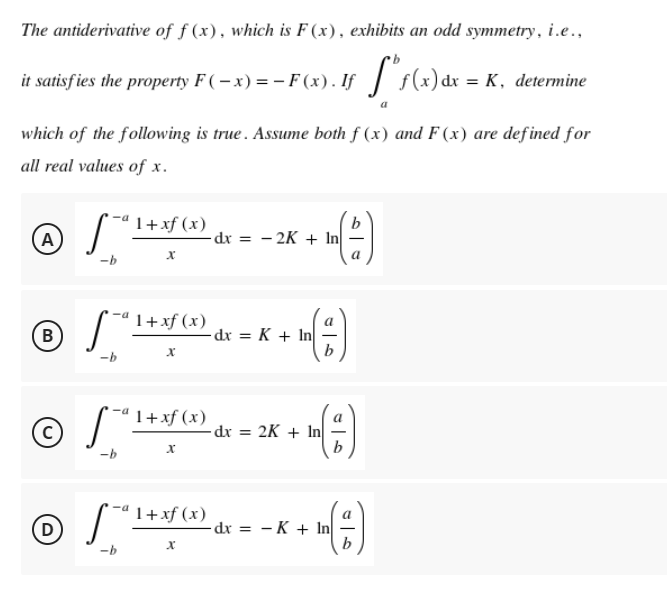The antiderivative of f (x), which is F (x), exhibits an odd symmetry, i.e., it satisfies the property F ( – x) = – F (x). If | f(x) dr = K, determine which of the following is true . Assume both f (x) and F (x) are defined for all real values of x. A 1+xf (x) b -dx = - 2K + In] a '1+xf (x) (B -dr = K + In b В 1+xf (x) -dr = 2K + In b '1+xf (x) -dx = - K + In b D
The antiderivative of f (x), which is F (x), exhibits an odd symmetry, i.e., it satisfies the property F ( – x) = – F (x). If | f(x) dr = K, determine which of the following is true . Assume both f (x) and F (x) are defined for all real values of x. A 1+xf (x) b -dx = - 2K + In] a '1+xf (x) (B -dr = K + In b В 1+xf (x) -dr = 2K + In b '1+xf (x) -dx = - K + In b D
Elements Of Modern Algebra
8th Edition
ISBN:9781285463230
Author:Gilbert, Linda, Jimmie
Publisher:Gilbert, Linda, Jimmie
Chapter5: Rings, Integral Domains, And Fields
Section5.4: Ordered Integral Domains
Problem 8E: If x and y are elements of an ordered integral domain D, prove the following inequalities. a....
Related questions
Question

Transcribed Image Text:The antiderivative of f (x), which is F (x), exhibits an odd symmetry, i.e..,
it satisfies the property F ( – x) = – F (x). If | s(x)dr =
which of the following is true . Assume both f (x) and F (x) are defined for
all real values of x.
'1+xf (x)
b
(A
-dr = - 2K + In
1+xf (x)
В
-dx = K + In|
1+xf (x)
-dr = 2K + In
1+xf (x)
a
D
-dr = - K + In|
b
-b
Expert Solution
This question has been solved!
Explore an expertly crafted, step-by-step solution for a thorough understanding of key concepts.
Step by step
Solved in 2 steps with 2 images

Recommended textbooks for you

Elements Of Modern Algebra
Algebra
ISBN:
9781285463230
Author:
Gilbert, Linda, Jimmie
Publisher:
Cengage Learning,

Functions and Change: A Modeling Approach to Coll…
Algebra
ISBN:
9781337111348
Author:
Bruce Crauder, Benny Evans, Alan Noell
Publisher:
Cengage Learning


Elements Of Modern Algebra
Algebra
ISBN:
9781285463230
Author:
Gilbert, Linda, Jimmie
Publisher:
Cengage Learning,

Functions and Change: A Modeling Approach to Coll…
Algebra
ISBN:
9781337111348
Author:
Bruce Crauder, Benny Evans, Alan Noell
Publisher:
Cengage Learning
